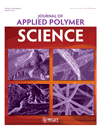Electrical and optical properties of polymer-Au nanocomposite films synthesized by magnetron cosputtering
Abstract
Polymer-Au nanocomposite films were prepared by co-sputtering from two independent magnetron sources. By sputtering from gold and polytetrafluoroethylene (PTFE) magnetrons, we prepared homogenous composite films using a rotatable sample holder. The microstructure of the nanocomposites was studied by transmission electron microscopy (TEM). The resistivity drops from 107 to 10−3 Ohm cm over a narrow range of metal content. The thin composite films show a strong optical absorption in the visible region due to surface plasmon resonances. The optical absorption has a strong dependence on the metal content, showing a red shift of the absorption peak from 550 nm to more than 700 nm with increasing gold content. © 2011 Wiley Periodicals, Inc. J Appl Polym Sci, 2012




